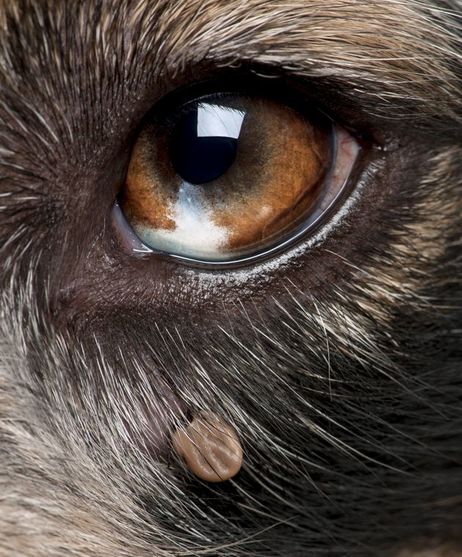Tick Paralysis
 123rf.com/profile_isselee
123rf.com/profile_isselee
Background Information:
There are over 70 types of ticks in Australia. However the main focus is on the paralysis tick (Ixodes Holocyclus). Paralysis ticks are commonly found in bush and coastal areas of the eastern side of Australia and are most active in Spring and early Summer. In Southeast Queensland, your pet may be at risk of tick paralysis all year, with the highest incidence between July and January.
The paralysis tick species (Ixodes holocyclus) is native to this area. The natural paralysis tick hosts are bandicoots and possums. These animals are rarely affected by tick paralysis.
You will find your pet is at risk of encountering an increased number of ticks after a short burst of rain followed by warm weather.
The paralysis ticks secrete a toxin in their saliva – the toxin has effects on the neurological, cardiac and respiratory function – in both pets and people.
Your pet usually becomes ill with clinical signs, somewhere between day 3 and 5 of attachment (in rare cases it has been up to 18 days after attachment). Once signs are obvious, the progression is rapid (24-48hours).
What are the signs that your pet has a tick?
The signs that your pet has a tick will start with subtle changes, however they progress rapidly and all tick paralysis cases are potentially fatal
Treatment
Preventing Tick Paralysis
As has been said many a time “Prevention is better than cure”.
There are many anti-tick products on the market, including chews, tick collars, spot-ons, sprays and rinses. It is best to talk to your local veterinarian regarding their recommendations. No product is perfect.
Other simple steps you can take to protect your pet include:
My pet has had a tick and has been discharged from hospital...what now?
Dogs:
Avoid all excitement for 2 weeks. Feed 2-3 small meals a day for next 4 days.
Precede each meal with a small volume of water to check swallowing is normal. If any gagging or spluttering with the water, do not give any food until the next meal is due, and try water first again. Check daily for Ticks. Avoid walking near creeks and areas with long grass. For all dogs on the property, consider using a recommended anti-tick product. Use daily inspections for ticks to ensure good control. Take care with prolonged exposure to sun and subsequent sunburn if the coat has been clipped short.
Cat:
Avoid all excitement for 2 weeks. Feed 2-3 small meals a day for next 4 days.
Precede each meal with a small volume of water to check swallowing is normal. If any gagging or spluttering with the water, do not give any food until the next meal is due, and try water first again. Check daily for Ticks. You may need to keep your cat indoors to avoid areas near creeks and areas with long grass for at least 2 weeks. Consider using Frontline spray over whole body every 3 weeks to assist in preventing ticks. Use daily inspections for ticks to ensure good control. Take care with prolonged exposure to sun and subsequent sunburn if the coat has been clipped short.
References
Cannon, M., 2014. Envenomation: Tick Paralysis. Australian Veterinary Association.
Pet Health - Information Sheets. 2014. [online] Aecvets.com.au. Available at: <http://www.aecvets.com.au/Pet-Health/Information-sheets.aspx> [Accessed 20 Apr. 2014].
There are over 70 types of ticks in Australia. However the main focus is on the paralysis tick (Ixodes Holocyclus). Paralysis ticks are commonly found in bush and coastal areas of the eastern side of Australia and are most active in Spring and early Summer. In Southeast Queensland, your pet may be at risk of tick paralysis all year, with the highest incidence between July and January.
The paralysis tick species (Ixodes holocyclus) is native to this area. The natural paralysis tick hosts are bandicoots and possums. These animals are rarely affected by tick paralysis.
You will find your pet is at risk of encountering an increased number of ticks after a short burst of rain followed by warm weather.
The paralysis ticks secrete a toxin in their saliva – the toxin has effects on the neurological, cardiac and respiratory function – in both pets and people.
Your pet usually becomes ill with clinical signs, somewhere between day 3 and 5 of attachment (in rare cases it has been up to 18 days after attachment). Once signs are obvious, the progression is rapid (24-48hours).
What are the signs that your pet has a tick?
The signs that your pet has a tick will start with subtle changes, however they progress rapidly and all tick paralysis cases are potentially fatal
- Staggering/wobbly gait (hind leg weakness)
- Change in voice or inability to vocalize (larynx paralysed)
- Reluctance to eat
- Regurgitation or vomiting
- Coughing and gagging (swallow has been effected)
- A “grunt” as they breath out
- Rapid breathing
- Difficulty in breathing
- Dilated pupils
Treatment
- If you find a tick on your pet, call your vet or an after-hours vet immediately.
- Prompt treatment, will give your pet their best chance of survival.
- The tick should be removed as soon as possible.
- It is important to remember that your pet will get worse for 12-24 hours before you can hope of showing for signs of improvement.
- Your pet will most likely be hospitalized. He/she will be sedated, and will receive the Tick Anti-Serum (TAS). Most pets remain in hospital for a minimum of 3 days.
- It may be necessary to clip short your pets coat or wash in an anti-tick product.
- Unfortunately when there is one tick there may be more. Multiple Tick Searches will be performed.
- Some pets may require intensive care treatment, including anesthesia and mechanical ventilation.
- Many pets will die from tick paralysis each year.
- Treating a pet for Tick Paralysis can be costly and prices may vary from $500-$10000+
Preventing Tick Paralysis
As has been said many a time “Prevention is better than cure”.
There are many anti-tick products on the market, including chews, tick collars, spot-ons, sprays and rinses. It is best to talk to your local veterinarian regarding their recommendations. No product is perfect.
Other simple steps you can take to protect your pet include:
- Avoid taking your pet to known tick areas. These include any bushland settings, creeks etc.
- Keep your own grass short
- Perform daily tick searchers on your pet – concentrating around the head and shoulders. Most ticks attach around the head – so be sure to check in and around ears, lips, eye lids and remove and check under collars.
- Consider clipping your pets coat – ticks are easier to find in a short coat.
- Don’t forget to check the whole pet, including legs, back, belly, between toes, on and under tails, in private areas.
My pet has had a tick and has been discharged from hospital...what now?
Dogs:
Avoid all excitement for 2 weeks. Feed 2-3 small meals a day for next 4 days.
Precede each meal with a small volume of water to check swallowing is normal. If any gagging or spluttering with the water, do not give any food until the next meal is due, and try water first again. Check daily for Ticks. Avoid walking near creeks and areas with long grass. For all dogs on the property, consider using a recommended anti-tick product. Use daily inspections for ticks to ensure good control. Take care with prolonged exposure to sun and subsequent sunburn if the coat has been clipped short.
Cat:
Avoid all excitement for 2 weeks. Feed 2-3 small meals a day for next 4 days.
Precede each meal with a small volume of water to check swallowing is normal. If any gagging or spluttering with the water, do not give any food until the next meal is due, and try water first again. Check daily for Ticks. You may need to keep your cat indoors to avoid areas near creeks and areas with long grass for at least 2 weeks. Consider using Frontline spray over whole body every 3 weeks to assist in preventing ticks. Use daily inspections for ticks to ensure good control. Take care with prolonged exposure to sun and subsequent sunburn if the coat has been clipped short.
References
Cannon, M., 2014. Envenomation: Tick Paralysis. Australian Veterinary Association.
Pet Health - Information Sheets. 2014. [online] Aecvets.com.au. Available at: <http://www.aecvets.com.au/Pet-Health/Information-sheets.aspx> [Accessed 20 Apr. 2014].
